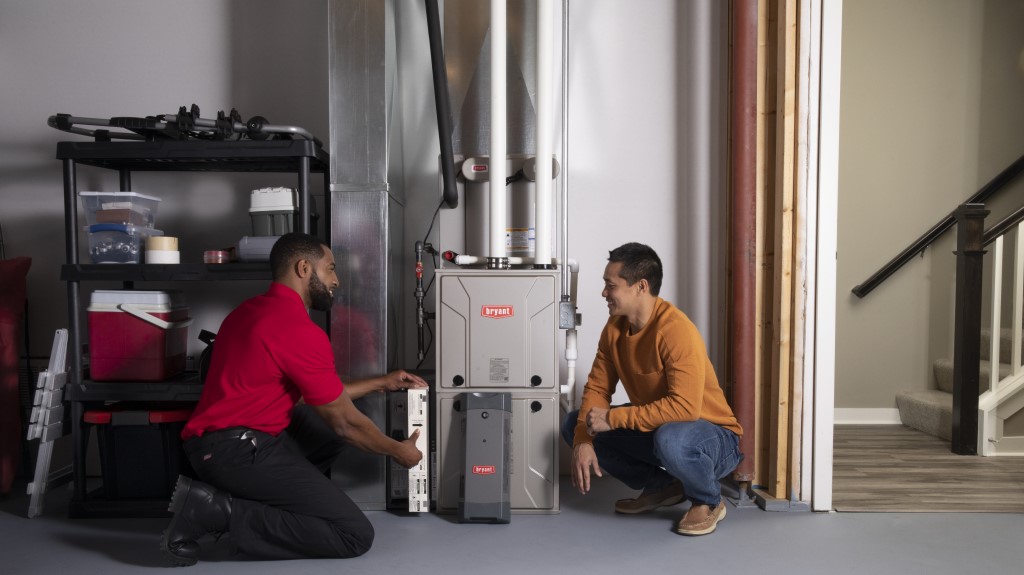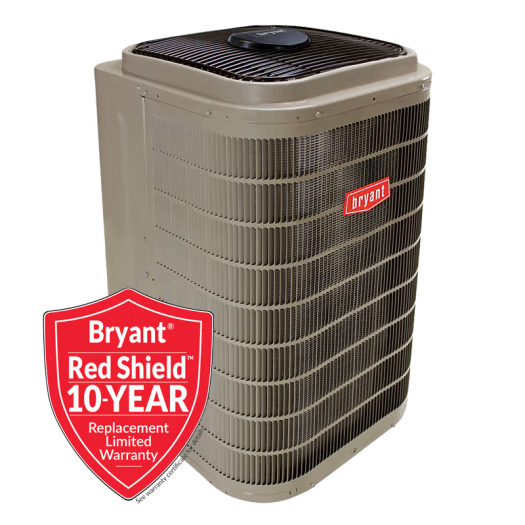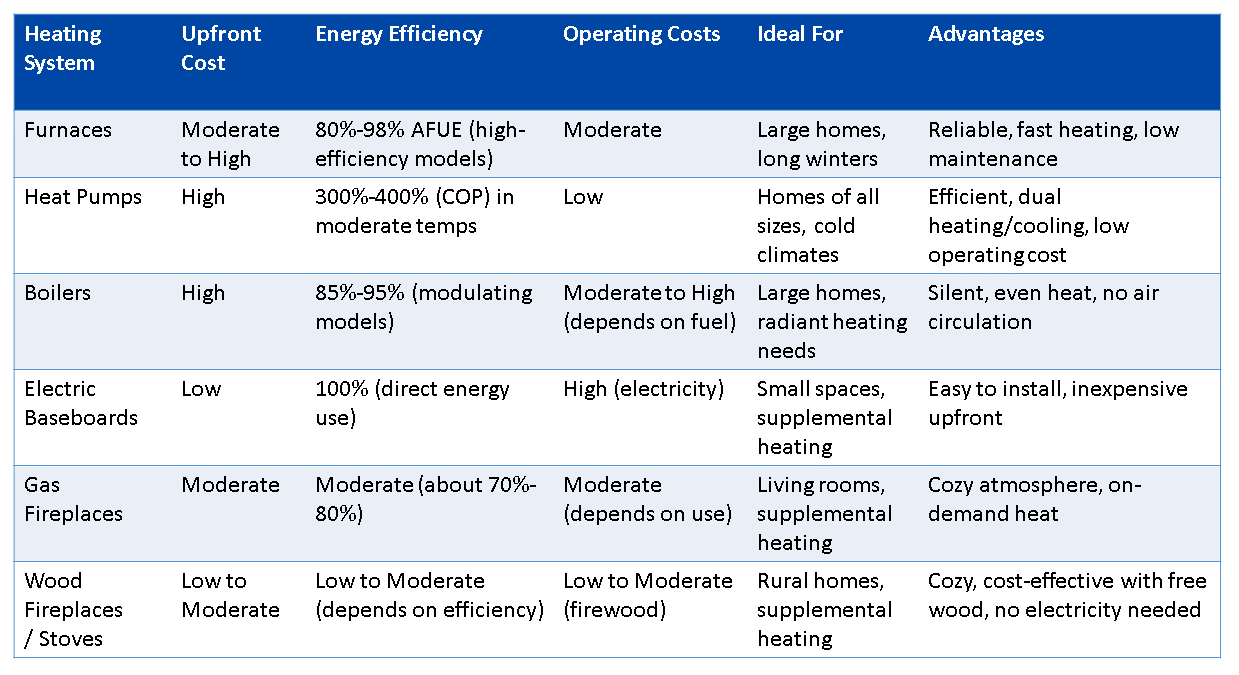In this blog, Ideal Heating & Air Conditioning will review the best home heating systems for Ontario homeowners. While furnaces are generally the most popular option for homeowners in Ontario, some people choose alternatives which you will learn about or they will opt for a hybrid heating system. Click on the links below or keep scrolling to read more.
1) What Is the Best Way To Heat Your Home in Ontario?
2) What Is the Most Common Heating System in Ontario?
3) The Pros and Cons of Each of the 6 Heating System Options for Ontario
a) Furnace
b) Heat Pump
c) Boiler
4) What Is the Best Heating System for Very Cold Climates?
5) What Are the Top 5 Heat Pumps?
6) What Are the Top 5 Furnaces?
Below, you’ll find all the information, including a comparison chart immediately following the contact button below. If you need help finding suitable home heating systems or you need general HVAC maintenance, please contact us.
1) What Is the Best Way To Heat Your Home in Ontario?
2) What Is the Most Common Heating System in Ontario?
The most common of home heating systems in Ontario is the natural gas furnace. There popularity is due to several key factors which we will explain below. Keep in mind, however, that In rural or remote areas where natural gas infrastructure is unavailable, other systems like propane furnaces, electric baseboards, or wood stoves may be more common.
Availability of Natural Gas
Natural gas is widely distributed across Ontario, especially in urban and suburban areas, making it a convenient and reliable energy source.
Cost-Effectiveness
Natural gas is generally cheaper than electricity or oil, making it an economical choice for heating in a province with long, cold winters.
Efficiency of Modern Furnaces
Many homes have upgraded to high-efficiency natural gas furnaces with AFUE ratings of 95% or more, reducing energy consumption and heating costs.
Compatibility with Ductwork
Most homes in Ontario already have duct systems for heating, ventilation, and air conditioning (HVAC), making it easy to install and maintain a gas furnace.
Government Incentives
Past rebate programs and incentives for upgrading to energy-efficient natural gas furnaces have encouraged homeowners to adopt this heating method.
While the most common heating system in Ontario is the natural gas furnace, which is favored due to its reliability, lower operating costs, and the widespread availability of natural gas., heat pumps are becoming increasingly popular. They are particularly popular in new builds or homes undergoing renovations, where homeowners are looking for more sustainable heating solutions or want the flexibility of heating and cooling in one system. Many homeowners in Ontario choose to pair a heat pump with a furnace, particularly in areas with very cold winters or for those seeking more energy-efficient solutions. This combination, known as a hybrid heating system or dual-fuel system, is becoming increasingly popular due to its ability to provide the best of both worlds: energy efficiency and reliable warmth during extreme cold.
3) The Pros and Cons of Each of the 6 Heating System Options for Ontario
In this next section, we’ll look at the 6 most common and efficient home heating systems in Ontario and breakdown the pros and cons of each. You’ll see our list includes the following heating systems: Furnaces, Heat Pumps, Boilers, Electric Base Boards, Gas Fire Places, and Wood Fireplaces / Stoves.
Keep in mind that some people enjoy hybrid systems. For example, a person may combine a gas furnace with a heat pump for optimal energy efficiency. The system switches between the two depending on outdoor temperatures, maximizing cost savings.
a) Furnace
The most common type of heating system in Ontario is, of course, a high-efficiency gas furnace. You may know that already, but let’s look at why.
Pros:
- Natural gas is widely available and affordable in Ontario.
- Modern furnaces with high Annual Fuel Utilization Efficiency (AFUE) ratings (95% or more) are cost-effective and environmentally friendly.
- Existing Ductwork: Many homes in Ontario are built with duct systems that support forced-air furnaces, simplifying installation.
- Rapid Heat Distribution: Furnaces use forced air to distribute heat through ducts, warming rooms quickly, which is essential in Ontario’s cold winters.
- Reliable in Extreme Cold: Unlike heat pumps, which may lose efficiency in extremely low temperatures, furnaces perform reliably even during harsh weather
Cons:
- Initial installation costs can be high if you’re upgrading an older system.
b) Heat Pump
Heat pumps (air source or geothermal) have gained in popularity lately and are particularly popular in regions that are more moderate. Here we’ll outline the differences between an air source heat pump and a geothermal heat pump, and then list the general pros and cons of this system.
Air source heat pumps use the outside air to heat or cool your home. They work by transferring heat between the outdoor air and your home’s interior, depending on the season. They work efficiently in temperatures as low as -25°C with newer models. They can also act as an air conditioner in summer.
Geothermal heat pumps use the earth’s stable temperature to provide heating. They are extremely energy-efficient and eco-friendly.
Pros:
- Significant energy savings over time.
- Rebates available in Ontario (Click here to learn more about heat pump rebates!)
Cons:
- High upfront installation costs (especially for geothermal systems)
- Their efficiency can drop in extreme cold, which is why some homeowners pair them with a backup heating system (e.g., a natural gas furnace or electric resistance heating)
c) Boiler
Boilers are another effective option for home heating in Ontario, particularly in older homes or those with radiant heating systems. They work by heating water and distributing the heat through radiators, baseboard heaters, or underfloor pipes.
Pros:
Efficient Heat Distribution: Provides consistent and comfortable heating without drafts. Ideal for radiant floor systems or traditional radiators.
Quiet Operation: No noisy fans or air movement as in forced-air systems.
Energy Efficiency: Condensing boilers are highly efficient, with up to 90-95% efficiency. Work well with zoning systems to heat only specific areas.
Long Lifespan: Boilers can last 15-30 years with proper maintenance.
Compatible with Renewable Energy: Can integrate with solar thermal systems for hot water.
Cons:
High Installation Cost: Installing a boiler and radiant heating system can be more expensive than a furnace or heat pump.
Slow Heating: Takes longer to heat a home compared to forced-air systems.
Limited Cooling Capability: Unlike heat pumps or furnaces with central AC, boilers don’t provide cooling.
Space Requirements: Requires a boiler unit and, for some systems, a hot water storage tank.
Fuel Dependence: Homes without natural gas access may need to use more expensive fuels like oil or propane.
Overall, boilers are considered more efficient than electric baseboards but typically less versatile than a heat pump. A boiler may pair well with a heat pump for hybrid systems, combining efficiency with radiant comfort.
d) Electric Base Board
Electric baseboard heaters tend to be used when it is more practical in terms of location, availability of infrastructure, or ease of upkeep. For example, in areas without access to natural gas infrastructure, electric baseboard heaters are a practical choice. Since baseboards don’t rely on fuel delivery (like oil or propane), making them convenient in isolated locations. Baseboard heaters are also ideal for compact spaces where a central heating system might be overkill. They are common in older apartment buildings or condos where retrofitting for other systems isn’t practical. They are also popular in cottages or vacation homes because they’re inexpensive to install and easy to maintain. They provide adequate heat for spaces that aren’t occupied year-round.
Pros:
- Easy to install and maintain.
- No ductwork is required, making them suitable for small spaces or as supplementary heating.
Cons:
- Higher operating costs due to Ontario’s relatively high electricity rates.
Often, electric baseboards are used to heat specific rooms or areas that need additional warmth (e.g., basements, bedrooms, or home offices) without heating the entire home.
e) Gas Fireplaces
Gas fireplaces are a popular choice for supplemental home heating in Ontario, particularly for creating cozy, warm spaces in living rooms, basements, or other common areas. They work by burning natural gas or propane to produce heat, which is then radiated into the room. Some models come with blowers or fans to distribute heat more effectively.
Pros:
- Ambiance: Provides a cozy atmosphere with the look and feel of a traditional fireplace but without the mess of wood or ash.
- Efficiency: Modern gas fireplaces can be energy-efficient, especially direct-vent models that minimize heat loss.
- On-Demand Heating: Can be turned on instantly and requires little maintenance compared to wood-burning fireplaces.
- Zone Heating: Allows homeowners to heat specific areas, potentially lowering heating costs for the rest of the home.
Cons:
- Limited Coverage: Ineffective as a sole heating system for large or multi-room homes.
- Installation Cost: Requires professional installation, including venting or connection to a gas line, which can be expensive.
- Fuel Cost: Ongoing costs for natural gas or propane may add up, especially if used extensively.
- Less Eco-Friendly: While cleaner than wood-burning, gas fireplaces still produce greenhouse gas emissions.
f) Wood Fireplaces / Stoves
Heating a home with a wood stove is an attractive choice for homeowners who value self-sufficiency, cost savings, or the ambiance of a traditional fire. Wood stoves are especially popular in rural and remote areas of Ontario, where access to natural gas might be limited, and firewood is readily available. They work by burning wood to produce heat, which radiates directly into the room or home.
Pros:
- Independence from Utilities: A wood stove can function without electricity, making it an excellent backup heating source.
- Cost-Effective: Firewood can be more affordable than other fuels, especially if sourced locally.
- Eco-Friendly (When Sustainable Wood is Used): Burning properly seasoned wood can be carbon-neutral, as trees absorb CO₂ during their growth.
- Ambiance: Offers a rustic, warm atmosphere that many find comforting.
Cons:
- Labour-intensive: Requires cutting, stacking, and seasoning wood, along with regular stove maintenance and ash removal.
- Inefficient for Whole-Home Heating: Works best for heating specific areas rather than entire homes unless combined with additional systems.
- Emissions: Older or improperly used stoves can produce significant particulate pollution.
- Safety Risks: Requires careful use and regular chimney cleaning to prevent fire hazards.
Many people choose wood stoves for their reliability during power outages, as they don’t rely on electricity to function. Additionally, they can be a cost-effective option for those who have access to inexpensive or free firewood, and they provide a cozy aesthetic that enhances the living space.

4) What Is the Best Heating System for Very Cold Climates?
The best heating system for very cold climates, such as those in Ontario, is often a high-efficiency furnace or a cold-climate air source heat pump (CCASHP). High-efficiency furnaces, particularly natural gas models with AFUE ratings of 95% or higher, are reliable and cost-effective, providing consistent heat even in extreme temperatures.
However, cold-climate air source heat pumps are becoming increasingly popular due to their ability to operate efficiently at temperatures as low as -25°C. These systems extract heat from the air, even in freezing conditions, and can also provide cooling in the summer, making them versatile. For optimal performance, many homeowners in very cold climates choose a hybrid system that combines a heat pump for moderate weather with a furnace for extremely cold days, ensuring efficiency and reliability throughout the winter.
If you want to learn more about the differences between furnaces and heat pumps, have a look at our blog, Heat Pump Vs Furnace.
5) What Are the Top 5 Heat Pumps?
In this section, you’ll see a list of the top 5 heat pumps or brands. We’ll also include the pros and cons in this list. Keep in mind that this list is not in any particular order.
a) Mitsubishi Electric SUZ Series
Designed for cold climates, this series offers efficient heating even in sub-zero temperatures, ensuring consistent comfort during Ontario’s harsh winters.
Pros: Energy-efficient, reliable performance in extreme cold.
Cons: Higher upfront costs, may require professional installation.
b) Daikin Heat Pumps
Known for energy efficiency and durability, Daikin provides models with excellent cold-weather performance, making them suitable for Ontario’s winters.
Pros: Energy-efficient, long-lasting, reliable.
Cons: Installation can be more complex due to advanced features.
c) Fujitsu Heat Pumps
Fujitsu offers high-efficiency heat pumps that operate effectively even during Ontario’s coldest days, with models designed specifically for low temperatures.
Pros: Excellent for cold climates, low energy consumption.
Cons: Premium pricing, installation may require specialized contractors.
d) Carrier Heat Pumps
Carrier heat pumps are known for advanced technology and reliability, offering superior efficiency and comfort in varying conditions.
Pros: High-quality, quiet operation, good warranty options.
Cons: Can be expensive upfront, and installation may be costly depending on the model.
e) Trane Heat Pumps
Trane is renowned for its durability and energy-efficient heat pumps, making them ideal for long-term performance in Ontario’s cold winters.
Pros: Reliable, efficient, great warranty.
Cons: Higher initial cost, may require extra maintenance if not properly maintained.
f) Bryant Heat Pumps
Known for excellent cold-climate performance, Bryant heat pumps, such as the Evolution® Extreme 24, offer efficient heating down to -25°C, perfect for Ontario’s winter conditions.
Pros: Energy-efficient, cold-weather performance, quiet operation.
Cons: Higher upfront costs, requires professional installation.
These heat pumps are all excellent choices for homes in Ontario, particularly in areas with very cold winters. Each offers a combination of energy efficiency, durability, and reliable heating performance.

6) What Are the Top 5 Furnaces?
Here are five top-rated furnaces commonly chosen by homeowners in Ontario, based on efficiency, reliability, and performance in cold climates. Again, please keep in mind that this list is not in any particular order.
a) Carrier Infinity® 98 Furnace
Known for its high efficiency (up to 98.5% AFUE), the Carrier Infinity® 98 offers advanced technology that adjusts heating output based on your needs, maximizing energy savings.
Pros: Extremely energy-efficient, quiet operation, smart thermostat compatibility.
Cons: Higher upfront cost, professional installation is essential.
b) Trane XC95m Furnace
This model is one of the most energy-efficient gas furnaces on the market with up to 97.3% AFUE, designed to provide maximum comfort even in Ontario’s coldest winters.
Pros: Extremely efficient, durable, and quiet; includes a modulating burner for precise temperature control.
Cons: Higher price point, complex installation.
c) Lennox SLP98V Furnace
With an efficiency rating of up to 98.7% AFUE, the Lennox SLP98V is a high-performance furnace that delivers excellent comfort with precise temperature control.
Pros: Ultra-efficient, variable-speed blower motor for consistent comfort, very quiet.
Cons: Expensive, requires professional installation.
d) Rheem Prestige Series 96 Furnace
Offering up to 96% AFUE, the Rheem Prestige Series 96 is known for its reliability and advanced features like a variable-speed motor and smart thermostat compatibility.
Pros: Great efficiency, durable, and includes a built-in diagnostic system.
Cons: Installation can be costly, some models may be loud compared to others.
e) Bryant Evolution® 987M Furnace
This furnace offers up to 98.3% AFUE, providing exceptional energy efficiency and precise comfort control with a variable-speed blower motor.
Pros: High energy efficiency, very quiet, excellent warranty options.
Cons: High upfront cost, requires professional installation.
These furnaces are all designed to perform reliably and efficiently in Ontario’s cold climate, helping homeowners stay warm while saving on energy costs. Many of these models are equipped with smart features, advanced technology, and variable-speed motors for consistent comfort. If you would like to learn more about some of the most energy-efficient furnaces, have a look at our blog, The 7 Most Energy Efficient Furnaces.

With so many choices, we recommend you talk with us at Ideal Heating & Air Conditioning to determine the best home heating systems for you and your family. With over 30+ years of experience in the heating and cooling industry, Ideal can help you find the most energy-efficient, reliable, and economic solution to keep you warm in even the coldest of winters. Browse our site to learn more about heating options, read our 5-star reviews, or contact us today!
